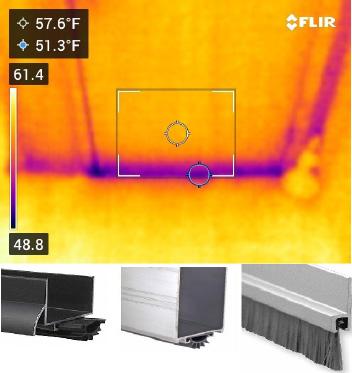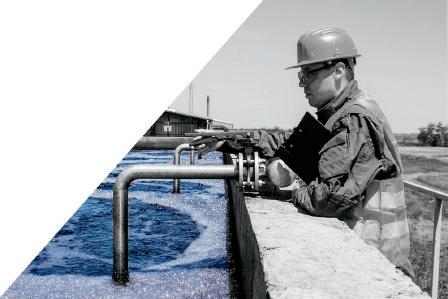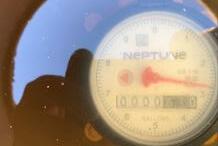
7 minute read
Bundled Up Tight
Michael Bertschinger, Energy Efficiency Circuit Rider
As the cooler temperatures of winter descend upon us, I am reminded of a young couple tackling life together. It was early winter, and they were excited to experience one of many firsts in their journey together, the purchase of their first home. It was a modest single wide trailer, but it was theirs, a place to call their own as they were looking at starting their family. This new journey allowed them to tackle new experiences and learn from them. One night during that first winter, the husband had been out pushing snow all night looking forward to coming home and going to sleep. The four days before he had been out each night de-icing and would spend the days repairing the equipment that had failed the nights before. This night had completed without incident and the upcoming sleep would be welcomed. Upon arriving home, he shed his winter gear and boots, trying to not wake her up. He went to the bathroom to wash his hands and no water flowed from the faucet! Following this was that sinking feeling, when you just know what is wrong. He made a quick phone call to borrow a salamander heater and dressed for the cold once again and started the process of thawing the pipes under the home. Luckily, it had been caught early enough and none of the piping had ruptured. My wife was incredibly grateful to have the ability to take a shower before she had to go to work that morning. (That’s right, this is my story.)
Advertisement
One of the things I learned from the incident was to step back and look at things that could have been prevented and their long-term cost. I could have set a salamander under the house for the rest of the winter and kept it running to be sure I would not have to deal with frozen pipes again. Figuring a salamander heater holds 4 gallons of fuel and runs for 12 hours on a tank, it would take 8 gallons to run 24 hours. Up until recent years, diesel was cheaper than kerosene, but diesel is what we will use in this example at $5.00 per gallon. So, to run a salamander for 24hrs for 60 days to keep a pipe from freezing would cost (8 gallons X $5.00 X 60 Days) $2,400 for the winter. This would work but it would probably not be the best use of resources. A 25-foot-long heat tape using 7 Watts per foot, with electricity costs on average at $0.10 per KWh, running for the same amount of time would use (7 Watts X 25 Ft= 175 Watts. 175 Watts X 24 Hours X 60 Days) $2.52. I think we can all agree this is a better solution for this problem.
My point here is this; just because something works does not make it the only way to solve the problem. Running a milk house heater at full power for the winter should guarantee the plumbing inside your well house does not freeze, but is it the best use of your resources? The heater uses 1500 Watts of electricity per hour, 1500 Watts X 24 Hours X 30 days = 1,080,000 Watts or 1,080 KWh equaling $108.00 per month when the outside temperature is below 70 degrees, usually during November through March.
Consider keeping a lower temperature inside the building, I recommend starting at 50 degrees. The lower temperature inside the well house slows the heat transfer from inside the building to the outside and reduces the amount of time the heater needs to run. This can be done with plug in thermostats ($30-$60), I prefer the ones with the digital display. (They also have programmable ones so you can make sure the well house is toasty when you come by for samples if you like). If installing a thermostat reduces the time your heater runs by 25%, it will pay for itself in the first two months.
When you are looking at your well house for this winter and getting ready to plug in that heater into that new thermostat, step back and look at things around the building.
Close the door, is there light coming in around the door anywhere? If so, then it is time to replace/install weatherstripping. This can be found from $0.30 to $0.65 per foot. The doorway, at 6’8” per side and 3’ across the top, will require about 16.2 feet to get the job done. If this will be a self-adhesive install, it would be best performed above 50 degrees. If the light is coming through at the bottom of the door, it is time to adjust/ replace the threshold. Check for adjustment screws for the threshold that allow it to be adjusted up or down or add a door sweep to the bottom of the door. Sweeps come in many styles, but they are all designed to slow or stop the air movement below the door. ($10.00). Another area to check is the door’s reveal, this is the spacing around the door, when it is closed, between the door and the jamb. This spacing should be consistent around the door to keep the door squared in the door jamb to prevent binding or dragging. If the reveal is not consistent it could require shimming the hinges or straightening bent hinges. Having a properly aligned reveal will help the weatherstripping and sweep do their jobs. And…that vent fan in the wall or ceiling, do you have an uncomplicated way to cover it for the winter? Keep it simple, try 2” foam board ($0.60 per square foot) and duct tape to cover the opening. You can always remove it quickly if needed. If daylight can pass though so can air leading to heat leaching to the outside faster. What kind of insulation do you have for the walls and ceiling? If your well house is a block building, consider adding insulation to the inside face of the walls.
Without these small building improvements, your heater must work harder and longer to keep the temperature in your well house at 50 degrees (because you are using that new plug-in thermostat, right?) and the money you could be saving will continue to bleed off into the cold nights.
THE FLOW CONTROL SOLUTIONS PROVIDER
Nebraska
Serving
Iowa Missouri Kansas
EXPERIENCE
Since 1962!
EQUIPMENT
Best in class!
EXPERTISE
Design & full service!
www.melleninc.com
IA & NE Office: 712-322-9333 MO & KS Office: 816-836-0202
RURAL WATER
Loan Fund

Reasons to Apply

About The Program
Apply today by contacting your State Rural Water Association or NRWA!
Reasons to apply
• Reasonable interest rates • NRWA does not charge administrative or processing fees • Straightforward application process • Quick turnaround
23
Reasonable interest rates No administrative or processing fees Straightforward application process and quick turnaround Systems must be public entities serving up to 10,000 persons, or in rural areas with no population limits Loan amounts may not exceed $200,000 or 75% of the total project cost, whichever is less Emergency loans are 90-day no interest, with immediate turn around on applications
Eligible Projects
Pre-development (planning) costs for infrastructure projects Replacement equipment, system upgrades, maintenance and small capital projects Energy efficiency projects to lower costs a Eligible Projects Includend improve sustainability • Pre-development (planning) costs for infrastructure projects Disaster recovery or other emergency • Replacement equipment, system upgrades, maintenance loans available and small capital projects • Energy efficiency projects to lower costs and improve
Applications, information and fo sustainability • Disaster recovery or other emergency loans availablerms can be downloaded from the NRWA website at nrwa.org or by scanning the QR Code above. For help, please call 1. Contact your State Rural Water Association or 800.332.8715 or email nrwarwlf@nrwa.org.
National Rural Water Association for
help with the application process. National Rural Water Association is an equal opportunity provider and employer. This material is based upon work supported by the Rural Utilities Service, United States Department of Agriculture.












